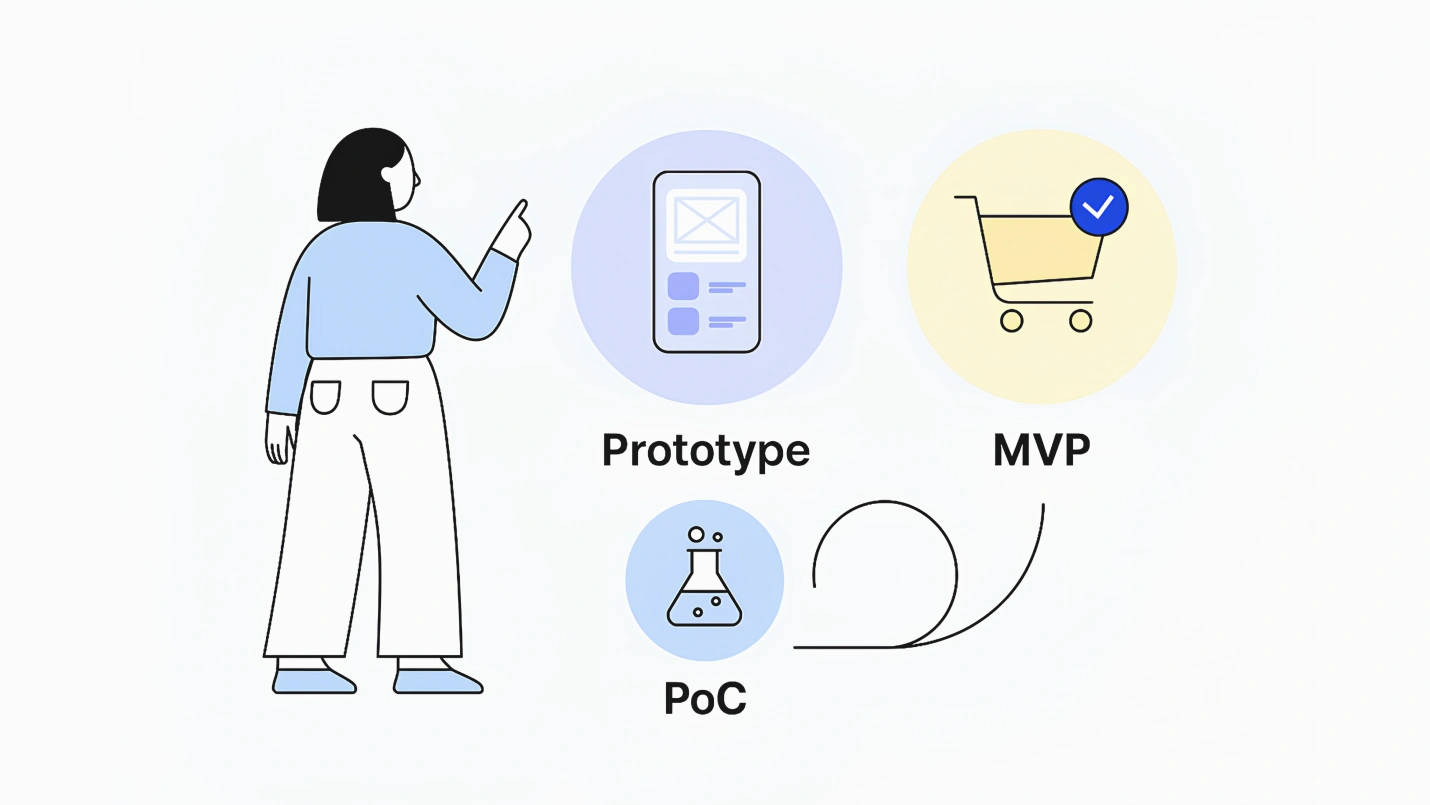While developing a new product, your ultimate goal should be to solve end-users’ problems. That’s how you would achieve the product-market fit and create a product that satisfies end users.
There are three ways to build products that can help you achieve product-market fit: Proof of Concept (PoC), MVP, and Prototyping. While all three are highly efficient, much must be clarified about which approaches to use and when. When you understand the difference between these three approaches, you will find yourself close to achieving your product-market fit utopia.
In this blog, we have tried erasing the thin line between PoC vs. MVP vs. Prototype and their role in validating a product. When you finish reading, you can easily decide:
- How is Proof of Concept (PoC), MVP, and Prototype different?
- When to use what strategy?
- What is the order of their execution?
PoC vs. MVP vs. Prototype — An Overview
Product validation should be a committed initiative that follows a chronological order, i.e., PoC > Prototype > MVP. However, you can skip creating a PoC if the idea has an existing validation in the market.
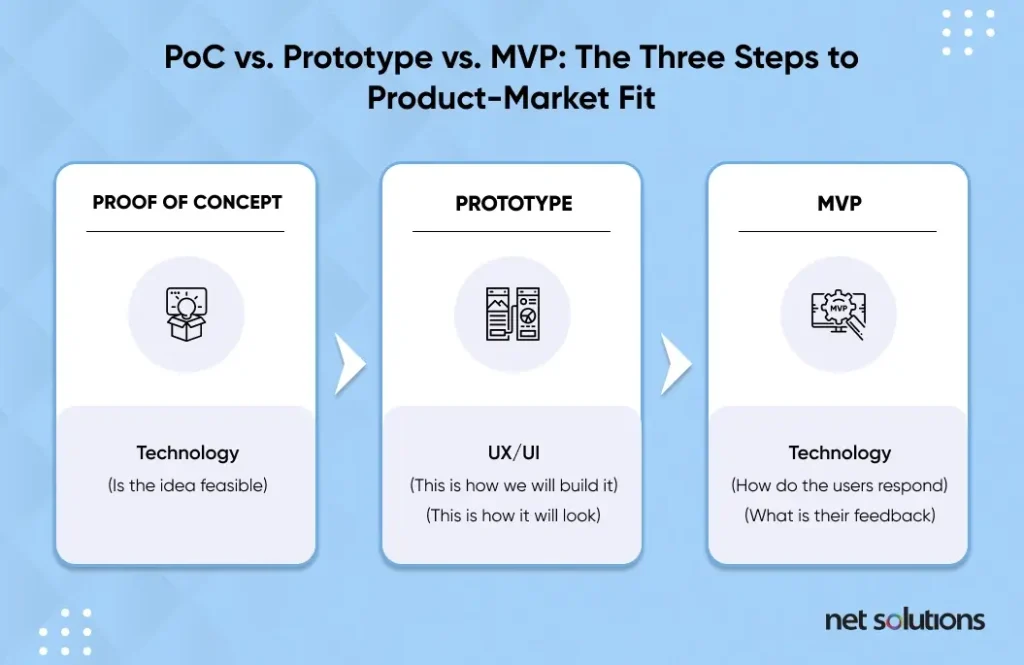
There are times when businesses confuse PoC vs. MVP vs. Prototype. This leads to a broken development process that fails to satisfy user needs and expectations.
“Over 30,000 new products are introduced yearly, and 95 percent fail.” — Clayton Christensen, Professor, Harvard Business Review
So, to create an idea that proves to be a cash cow, you need to understand PoC, Prototype, and MVP — the three foundations for the new product development process. Let’s dig deep and see what each implies and their role in assuring product-market fit.
What is PoC (proof of concept)?
Goal: To find out whether the idea is technically feasible.
Proof of concept (PoC) is the first step to consider before moving ahead with the development process. As the name implies, proof of concept is proof that the idea is feasible and can be converted into a product.
If the concept pre-exists in the market, you don’t need to build a PoC on it. But, if your startup is innovating and onto digital disruption, a PoC can help you gather evidence of whether the idea is practical and can be presented to the stakeholders and investors. Understanding your expectations from a PoC is essential when creating it.
What is the purpose of a PoC?
- Validate the practicality of an idea
- Save money, time, and other resources
- Convince stakeholders to invest in the idea
- Get an idea about the impending risks from early on
How does proof of concept (PoC) work?
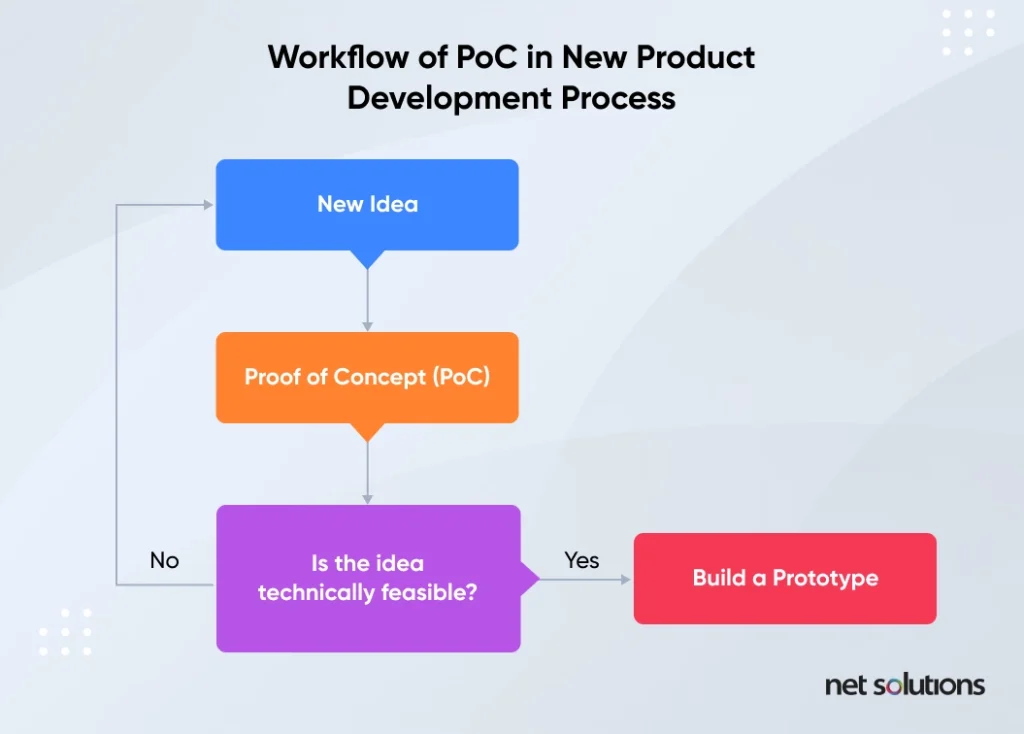
An explanation of concept (PoC) works in the following steps:
1. Defining objective: We identify the project’s end goal by asking the following questions:
- What aspects of the idea do you want to validate?
- Do you seek any answers from the proof of concept (PoC)?
- What is the final goal you want to achieve from the PoC?
2. Plan and design the PoC: After defining our objectives from the PoC and having concrete answers to the above questions, we develop a detailed plan to conduct the proof of concept. Here’s what we do at this stage:
- Deciding on the timeline, scope, and required resources for conducting the proof of concept (PoC).
- Outline the features and hypotheses that you need to test.
3. Develop a prototype: We create a prototype of the idea focusing on core elements we need to validate in the PoC.
4. Testing and evaluating the prototype: We conduct tests and experiments to evaluate the prototype’s performance, functionality, and feasibility. At this stage, we gather data, analyze results, and compare the findings against predefined objectives to identify strengths, weaknesses, and potential areas for improvement.
5. Refine and iterate: We refine and iterate the prototype based on the results and feedback from testing. The modification helps improve the concept and increase its viability.
6. Document and present findings: Document the entire process, including the objectives, methodology, results, and conclusions in a report. It helps communicate the outcomes of the PoC to stakeholders.
Based on the feedback, stakeholders can make informed decisions about the idea. They can decide whether to move forward with full-scale development, make modifications, seek additional funding, or discontinue the project.
PoC (Proof of Concept) example
In 2009, Twitter released the rough version of OAuth as a closed beta (Application-Only Authentication) on Google’s discussion group. It was a proof of concept validation code that demonstrated the idea and the possibility of executing it.
Today, Twitter’s PoC code for OAuth is the reality of almost every application’s registration and authentication process.
Proof of concept (POC) best Practices
- Ensure that the objectives of your PoC are specific, measurable, achievable, relevant, and time-bound (SMART). It will keep your focus steady and help you accurately measure your PoC’s success.
- Start small by focusing only on the core features of the PoC at the beginning. This way, you can have better control, faster iterations, and quicker validation of key assumptions.
- Determine the criteria that will define the success of the POC. Ensure these criteria align with the objectives and help evaluate the concept’s feasibility, performance, or potential.
- Use actual or representative data during the POC to ensure that the tests and evaluations closely resemble the existing scenarios. It would also offer accurate insights into the concept’s viability.
- Set realistic timelines for the POC to avoid rushing or dragging out the process.
- Engage stakeholders throughout the POC process by seeking input, gathering feedback, and addressing concerns. It would foster collaboration, increase buy-in, and help to align the POC with business objectives.
- Document and track each step of the POC, including the methodology, assumptions, experiments conducted, results, and lessons learned to facilitate analysis, reporting, and future reference.
- Continuously monitor the POC to gather data and measure its performance against the defined success criteria to assess your idea’s effectiveness, feasibility, scalability, and user feedback.
- Be open to feedback, learn from the findings, and iterate on the concept or prototype to increase the chances of a successful outcome.
- Communicate the findings, results, and recommendations of the POC to stakeholders and decision-makers.
What is a Prototype?
Goal: To demonstrate how the product will look
A prototype is a draft version of the product that focuses on its user experience and semantics. The word prototype originates from a Greek word that means “in a primitive form.”
In Product Development, prototype refers to the alpha grade, i.e., it is the first version that can run to showcase the flow of elements and the overall look and feel of the product. Always create a prototype before moving on to the MVP, as you know what the product will be like from early on.
What is the purpose of a prototype?
- Visualize the functionality and design
- Validate the user experience design
- Help gain early feedback on the product
- Attract seed funding from potential investors
How does prototyping work?
Prototyping works in the following steps:
Step 1: We identify the prototype’s purpose, i.e., whether you want to use it to validate the design, test functionality, gather user feedback, or showcase the concept to stakeholders.
Step 2: We develop initial ideas and concepts for the prototype. This stage involves brainstorming, sketching, and creating basic design representations to capture the product’s essential features and functionality.
Step 3: We select the prototype type based on the purpose, complexity, and available resources. Here are the prototypes we can choose from
- Paper prototype: A low-fidelity prototype created using sketches or printouts, usually to test the user interface and interaction design.
- Wireframe prototype: A simplified digital prototype that represents the structure and layout of a product or website, typically focusing on user experience.
- Functional prototype: A working model demonstrating key features and functionality, often built using technologies or components similar to the final product.
- Visual prototype: A high-fidelity representation closely resembles the final product regarding appearance and aesthetics.
- Virtual prototype: A digital 3D model or simulation that allows interaction and visualization of the product without physically creating a physical model.
Step 4: We build the prototype using the chosen prototype type. Here are some of the ways we can choose from to make it:
- 3D printing
- Rapid prototyping
- Software development
- Manual assembly
Step 5: We test the prototype to evaluate its functionality, usability, and performance. The feedback we gather at this stage helps us refine the prototype by making necessary improvements.
Step 6: We iterate the prototype based on the feedback and insights gathered during testing. We refine the prototype till we achieve the desired outcomes.
Step 7: We record and document the design specifications, materials used, and lessons learned during the prototyping process for future reference or pitching your idea to investors.
Example of prototype
Twitter rolled out its new prototype app, “twttr,” in early 2019 and urged end-users to try and test it. Twitter built this prototype to experiment with new features around responses, i.e., it is Twitter’s initiative to make long conversations easy to read.
Here’s an excerpt on how a user reacted to the new “twttr” feature for changed conversation threads.
Hmm unsure how I feel about the chunky blocks. I think they have their place in messaging apps but they look weird indented. I do like the indication of the original tweeter w stripe if color. Playing w/shades of colors or smthng more subtle would be nice #twttr #LetsHaveAConvo pic.twitter.com/uQTOlrM0Mz
— Yong Li Dich (@yonglidich) March 12, 2019
Prototyping best practices
- Start with the inside-out approach during prototyping. It means prioritizing the essential information for users instead of getting basic navigation elements down first. It would help you create a user-friendly prototype.
- Don’t get caught up in too many details while building a prototype. Only focus on what matter the most. Usually, 20% of your mobile app accounts for the most user interactions. Get them right first and move to the next stage.
- Identify all the ways users can interact with your product. You wouldn’t want to miss out on users because you couldn’t identify and include their journey in the product.
- Get the right users to test your product. Ideally, you must balance between users who’re experienced in a domain or who’re entirely new to it.
What is an MVP (Minimum Viable Product)?
Goal: Launch, learn, and iterate based on user feedback
MVP, an acronym for a minimum viable product, is a workable product loaded with only essential features that define the product. MVP Development leads to a standalone application that is launch-ready. Any further product developments and feature additions are then based on continuous valuable feedback that keeps flowing in from the end users to the MVP development company.
“It’s the smallest thing you can create that proves a single premise through validated learning. It should be high quality because you need to incrementally build it out if your premise is correct.” — Eric Reis, Author, The Lean Startup
MVP in software development combines essential microservices focusing on building one complete thing at a time. The most important thing to remember when building an MVP — do not to create messy code in a hurry to launch. The lesser the cruft, the easier it is to iterate and maintain it later.
What is the purpose of an MVP?
- Gather early feedback from the end-users
- Facilitate faster time-to-market
- Save the product from failure
- Save time, money, and other resources
How does an MVP work?
A minimum viable product (MVP) works in the following steps:
Step 1: We define a product’s value proposition or the problem it aims to solve. This stage acts as the foundation of your MVP.
Step 2: We identify the minimal features you need to address the core problem or deliver the value proposition. We stick to core, simple features that align with your product’s functionality.
Step 3: We build a functional prototype demonstrating the core features of your product. It should only offer a realistic user experience. We don’t need to refine or scale it yet.
Step 4: We release the MVP to selected users or early adopters for feedback.
Step 5: We gather and analyze the feedback and use it to improve our product. We resolve the user-identified pain points with each update and continue releasing new versions until the MVP reaches a mature and market-ready state.
MVP (Minimum Viable Product) example
A podcast platform Odeo came up with the idea of creating a messaging-based platform to help people communicate. The platform, also called “twttr” supported minimal features and was for internal use only.
Initially, it looked like this:
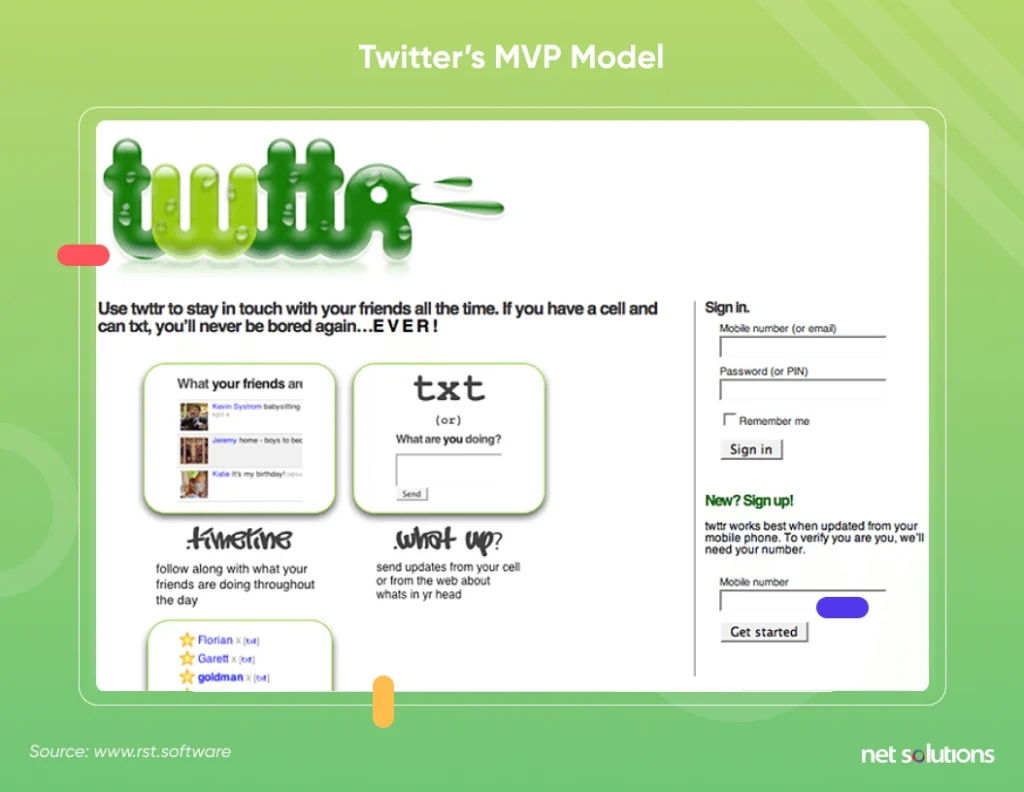
This was Twitter’s MVP, which was later released to the public and was continuously refined based on end-user feedback.
Best practices for building a successful MVP
- Before creating an MVP, consider what you want to achieve with your product and its target uses. This way, you can get a clear idea of who are your target users and how you plan to resolve their pain points.
- Keep your MVP minimum and focus only on the functional requirements of your product. This way, you can plan and budget it better.
- Don’t just settle on one MVP, as there are chances that if it fails, you may have to go back to the drawing board. Keep multiple options for fallback if the current MVP doesn’t pan out well.
- Always build an MVP with a long to medium-term market perspective. It would help you think and plan ahead of the curve.
- Keep all the stakeholders on the same page. It helps them understand how their contribution fits the large picture, and they collaborate better with you.
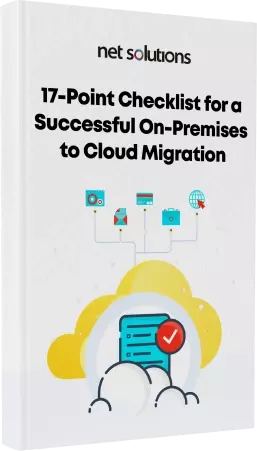
We respect your privacy. Your information is safe.
PoC vs. Prototype vs. MVP: Differentiating Between the Three
There is a difference between a prototype, minimum viable product, and proof of concept. The approach is different, and so is the objective.
Here’s a chart that summarizes PoC vs. MVP vs. Prototype for ease of understanding.
| Proof of Concept | Prototype | Minimum Viable Product |
|---|---|---|
| Intent: Validate technical feasibility |
Intent: Validate the UX and UI design and the flow of elements within the interface |
Intent: Validate the initial likeability for the product. The minimal feature product is launched early with a serious commitment to refactoring |
| Estimated Time to Build: Days |
Estimated Time to Build: Weeks |
Estimated Time to Build: Months |
| Target Audience: Developer groups |
Target Audience: Stakeholders, developer groups, limited end users |
Target Audience: End users |
| Intent: Validate technical feasibility |
Intent: Validate the UX and UI design and the flow of elements within the interface |
Intent: Validate the initial likeability for the product. The minimal feature product is launched early with a serious commitment to refactoring |
| Best Use Case: Aiming for digital disruption. That is, a concept that has never been tried before |
Best Use Case: Looking for opportunities to attract seed funding by presenting how the product will be built |
Best Use Case: Ensure faster time to market while sticking to the aim of analyzing, initial target audience response |
| PoC vs Prototype: Checks whether you can convert an idea into a product or not. The answer is either yes or no. |
PoC vs Prototype: The first draft of the product that follows after a validated PoC. It gives an idea of the flow of elements within the application. |
|
| MVP vs Prototype: A prototype is a skeleton version that is made available to the stakeholders for internal review on the look and feel of the application |
MVP vs Prototype: MVP is a ready-to-launch version of the product that is not rolled back but iterated with new features based on user feedback |
|
| MVP vs PoC: The innovative features are implemented to check whether it is possible to execute or not |
MVP vs PoC: MVP is a basic version, embedded with workable, primary, innovative features and can be launched in the market |
PoC vs. MVP vs. Prototype: Which One Should You Choose?
Like any expert software development company would tell you, it is a good practice to rely on all three strategies if you have the bandwidth, talent, and other resources to pull it off. The orchestration of PoC, MVP, and prototype saves you from the chances of product failure.
However, your business and functional requirements have an equal hand in deciding your strategy when brainstorming between PoC vs. MVP vs. Prototype.
Here is an insight into when to use what strategy:
When to use Proof of Concept (PoC)?
- If you want to make an informed decision before investing your time and money into the product development endeavor
- When you are building a new product with the idea that has not been tried and tested before
- You need to represent the technical feasibility of the idea to investors
- Need to encourage the teams with the possibility of the idea that otherwise seems tricky to implement
When to use a prototype?
- Need to visualize the look and feel of the product to see how it will turn out in the long run.
- Need to showcase the product’s design and UX flow to the investors to attract seed funding.
- You have a short deadline to represent your idea to the stakeholders and investors.
- You need to show the product to the end-users for their likeability before moving on with actual development.
When to use the minimum viable product (MVP)?
- When you want to ensure faster time-to-market and offer immediate value through digital transformation
- To gather early fanbase and feedback that can form the basis for further refinements
- If you wish to understand the market dynamics and the response to your product in the market
- You wish to create a user-centric product, i.e., developing a product — for the people and by the people
Frequently Asked Questions
An MVP is a fully-functional product with complete yet minimal features. On the other hand, a prototype is a simulation of the software designed to look and feel like a real product. It is fully functional but doesn’t have exclusive features.
- Rapid prototyping: Also known as throwaway prototyping, the rapid prototyping approach aims to create prototypes that are relevant only in the short term, such as one agile sprint. The prototype goes through several cycles until all stakeholders are satisfied. Once the sprint is complete, we discard the prototype and build a new one for the next sprint.
- Evolutionary prototyping: The starting point in evolutionary prototyping is a functional piece of software that only meets the understood requirements. The team keeps adding new features as the requirements become clear to stakeholders.
- Incremental prototyping: In incremental prototyping, we build several separate prototypes in parallel. Then, we evaluate and refine each prototype and merge them into a comprehensive whole.
- Extreme prototyping: Extreme prototyping happens in three phases: Build, transform, and code. In the build phase, we create HRM wireframes to simulate the presentation layer. In the transformation phase, we convert the wireframes to fully-functional HTML pages and tie them to the simulated services layer. In the code phase, we implement the services layer.
In agile software development, we call a proof of concept a Spike, a time-boxed research and development activity for investigating and validating a solution.
- Low fidelity prototypes: Low-fidelity prototypes look like the rough sketch of an idea. Their purpose is to confirm early whether an idea is feasible. It is also an effective way of asking users about their product’s vision or flow.
- High-fidelity prototypes: High-fidelity prototypes look like finished products. The purpose is to confirm whether a product’s interface is intuitive or needs improvement.

